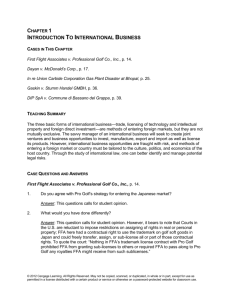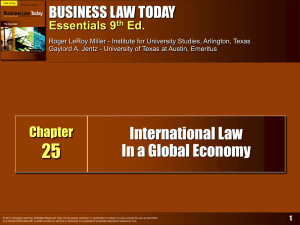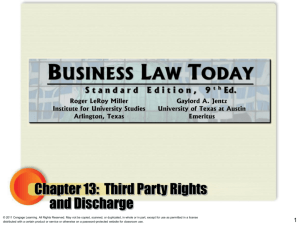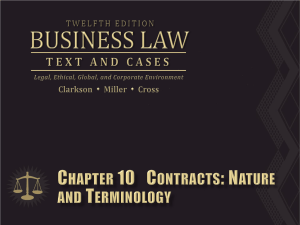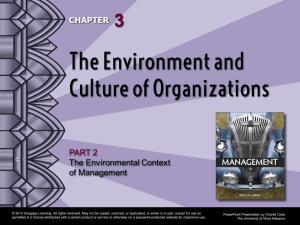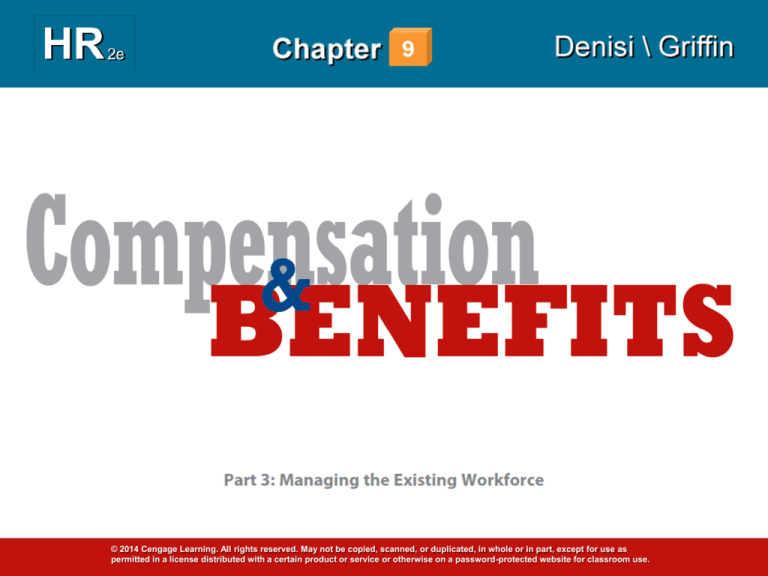
© 2014 Cengage Learning. All rights reserved. May not be copied, scanned, or duplicated, in whole or in part, except for use as
permitted in a license distributed with a certain product or service or otherwise on a password-protected website for classroom use.
Learning Objectives
After studying this chapter, you should be able to:
1. Describe the basic issues involved in developing
a compensation strategy
2. Discuss how organizations develop a wage and salary
structure
3. Identify and describe the basic issues involved in wage
and salary administration
4. Discuss the basic considerations in understanding benefit
programs
5. Identify and describe mandated benefits
6. Identify and describe nonmandated benefits
7. Discuss contemporary issues in compensation and benefits
© 2014 Cengage Learning. All rights reserved. May not be copied, scanned, or duplicated, in whole or in part, except for use as
permitted in a license distributed with a certain product or service or otherwise on a password-protected website for classroom use.
9–2
What Is Compensation?
The set of rewards that organizations
provide to individuals in return for their
willingness to perform various jobs and
tasks within the organization.
© 2014 Cengage Learning. All rights reserved. May not be copied, scanned, or duplicated, in whole or in part, except for use as
permitted in a license distributed with a certain product or service or otherwise on a password-protected website for classroom use.
9–3
What are Benefits?
Purposes of Benefits
Rewards
Incentives
Items of Value
© 2014 Cengage Learning. All rights reserved. May not be copied, scanned, or duplicated, in whole or in part, except for use as
permitted in a license distributed with a certain product or service or otherwise on a password-protected website for classroom use.
9–4
Beyond the Book:
Components of the Compensation System
© 2014 Cengage Learning. All rights reserved. May not be copied, scanned, or duplicated, in whole or in part, except for use as
permitted in a license distributed with a certain product or service or otherwise on a password-protected website for classroom use.
9–5
Understanding the Basic
Purposes of Compensation
Developing a
Compensation Strategy
Internal
Equity
External
Equity
Pay
Surveys
Legal
Standards
© 2014 Cengage Learning. All rights reserved. May not be copied, scanned, or duplicated, in whole or in part, except for use as
permitted in a license distributed with a certain product or service or otherwise on a password-protected website for classroom use.
9–6
Organizational Considerations:
Linking Compensation to Performance
Motivation
Retention
Controlling
costs
Productivity
Organizational
objectives
© 2014 Cengage Learning. All rights reserved. May not be copied, scanned, or duplicated, in whole or in part, except for use as
permitted in a license distributed with a certain product or service or otherwise on a password-protected website for classroom use.
9–7
Example of a Pay Survey
© 2014 Cengage Learning. All rights reserved. May not be copied, scanned, or duplicated, in whole or in part, except for use as
permitted in a license distributed with a certain product or service or otherwise on a password-protected website for classroom use.
9–8
Wages Versus Salaries
• Wages
Is hourly compensation paid to
operating employees; basis for
wages is time.
• Salary
is income paid to an
individual on the basis
of performance, not on
the basis of time.
© 2014 Cengage Learning. All rights reserved. May not be copied, scanned, or duplicated, in whole or in part, except for use as
permitted in a license distributed with a certain product or service or otherwise on a password-protected website for classroom use.
9–9
Strategic Options for Compensation Levels
Which pay level is a firm on
the decline likely to choose?
© 2014 Cengage Learning. All rights reserved. May not be copied, scanned, or duplicated, in whole or in part, except for use as
permitted in a license distributed with a certain product or service or otherwise on a password-protected website for classroom use.
9–10
Determinants of an Organization’s
Compensation Strategy
Overall
strategy of the
organization
Overall ability
of organization
to pay
Ability to
attract and
retain
employees
© 2014 Cengage Learning. All rights reserved. May not be copied, scanned, or duplicated, in whole or in part, except for use as
permitted in a license distributed with a certain product or service or otherwise on a password-protected website for classroom use.
Strength of
union
influence
9–11
Determining What to Pay
Job Evaluation
Methods
Classification
system
Point
system
Factorcomparison
method
© 2014 Cengage Learning. All rights reserved. May not be copied, scanned, or duplicated, in whole or in part, except for use as
permitted in a license distributed with a certain product or service or otherwise on a password-protected website for classroom use.
9–12
Establishing a Classification System
for Job Evaluation
• Group sets of jobs into grades
• Rank grades at level of importance
to the organization
• Determine how many categories or
classifications to use for grouping jobs
© 2014 Cengage Learning. All rights reserved. May not be copied, scanned, or duplicated, in whole or in part, except for use as
permitted in a license distributed with a certain product or service or otherwise on a password-protected website for classroom use.
9–13
Job-Classification
System
© 2014 Cengage Learning. All rights reserved. May not be copied, scanned, or duplicated, in whole or in part, except for use as
permitted in a license distributed with a certain product or service or otherwise on a password-protected website for classroom use.
9–14
Using a Point System for Job Evaluation
• Compensable Factors
Job skills
Physical effort
Working conditions
Responsibility and authority
• Point Manual
Defines points assigned to the increasing
degrees of compensable factors for which the
organization willing to provide payment
© 2014 Cengage Learning. All rights reserved. May not be copied, scanned, or duplicated, in whole or in part, except for use as
permitted in a license distributed with a certain product or service or otherwise on a password-protected website for classroom use.
9–15
Using the Factor-Comparison Method
for Job Evaluation
1. Define comparison factors to be used
2. Identify benchmark or key jobs in the organization
3. Rank benchmark jobs on each compensation factor
4. Allocate benchmark’s job wage to each job factor
based on the relative importance of the job factor
5. Prepare two sets of ratings based on ranking and
assigned wages to determine evaluator consistency
6. Develop a job-comparison chart to rate other jobs in
the organization as compared to the benchmark jobs
© 2014 Cengage Learning. All rights reserved. May not be copied, scanned, or duplicated, in whole or in part, except for use as
permitted in a license distributed with a certain product or service or otherwise on a password-protected website for classroom use.
9–16
Factors Affecting Internal Pay Levels
• Pay-for-Knowledge
Compensating employees for
learning specific information
• Skill-based Pay
Rewards employees for
acquiring new skills
• Seniority
A maturity curve specifies the amount of
annual increase a person will receive for
time on the job with the firm.
© 2014 Cengage Learning. All rights reserved. May not be copied, scanned, or duplicated, in whole or in part, except for use as
permitted in a license distributed with a certain product or service or otherwise on a password-protected website for classroom use.
9–17
Wage and Salary
Administration
The ongoing process of managing a
wage and salary structure; managers
must be sensitive to these costs and
must be vigilant about managing them
properly.
© 2014 Cengage Learning. All rights reserved. May not be copied, scanned, or duplicated, in whole or in part, except for use as
permitted in a license distributed with a certain product or service or otherwise on a password-protected website for classroom use.
9–18
Understanding Compensation
Wage and Salary
Administration Issues
Pay
Secrecy
Pay
compression
Pay
Inversion
© 2014 Cengage Learning. All rights reserved. May not be copied, scanned, or duplicated, in whole or in part, except for use as
permitted in a license distributed with a certain product or service or otherwise on a password-protected website for classroom use.
9–19
The Nature Of Benefits Programs
Benefits Issues
Rising
Costs
Global
Differences
Employee
Preferences
© 2014 Cengage Learning. All rights reserved. May not be copied, scanned, or duplicated, in whole or in part, except for use as
permitted in a license distributed with a certain product or service or otherwise on a password-protected website for classroom use.
9–20
Purposes of Benefit Programs
• Efficiency Wage Theory
An organization saves money when its
benefits and compensation package attracts
better-qualified people and motivates its
employees to work harder and remain with
the organization.
© 2014 Cengage Learning. All rights reserved. May not be copied, scanned, or duplicated, in whole or in part, except for use as
permitted in a license distributed with a certain product or service or otherwise on a password-protected website for classroom use.
9–21
Types of Benefits
• Mandated Benefits
• Other Benefits
Unemployment insurance
Wellness programs
Social Security
Life-cycle benefits
Workers’ Compensation
• Nonmandated Benefits
Private pension plans
Defined benefit plans
Defined contribution plans
Child-care programs
Elder-care
Employee assistance
Cafeteria-style benefits
Spousal equivalents
Paid time off
Health insurance
© 2014 Cengage Learning. All rights reserved. May not be copied, scanned, or duplicated, in whole or in part, except for use as
permitted in a license distributed with a certain product or service or otherwise on a password-protected website for classroom use.
9–22
Minimum Annual Vacation by Law
in Different Countries
© 2014 Cengage Learning. All rights reserved. May not be copied, scanned, or duplicated, in whole or in part, except for use as
permitted in a license distributed with a certain product or service or otherwise on a password-protected website for classroom use.
9–23
Executive Compensation Components
• Base Salary
• Incentive Payments
Usually a bonus based on
company performance
• Perquisites
© 2014 Cengage Learning. All rights reserved. May not be copied, scanned, or duplicated, in whole or in part, except for use as
permitted in a license distributed with a certain product or service or otherwise on a password-protected website for classroom use.
9–24
Cash Bonuses For Some CEOs
2010
2011
Lloyd Blankfein (Goldman Sachs)
$12.60 million
$ 7.00 million
James Gorman (JP Morgan)
$13.00 million
$10.50 million
Howard Schultz (Starbucks)
$22.00 million
$16.00 million
Robert Diamond (Barclays PLC)
$ 3.25 million
$ 1.70 million
Phillipe Dauman (Viacom)
$12.00 million
– BUT his total compensation fell from $84.5 million to $43 million
$20.00 million
© 2014 Cengage Learning. All rights reserved. May not be copied, scanned, or duplicated, in whole or in part, except for use as
permitted in a license distributed with a certain product or service or otherwise on a password-protected website for classroom use.
9–25
Legal Issues in Compensation
and Benefits
• Fair Labor Standards Act (FLSA)
Includes provisions for the minimum wage,
overtime, comp time, and child labor
HR managers must adhere to overtime laws
• Employee Retirement Income Security Act
(ERISA)
Vesting provisions guarantee employee rights
to receive earned benefits from PBGCinsured pension plans
© 2014 Cengage Learning. All rights reserved. May not be copied, scanned, or duplicated, in whole or in part, except for use as
permitted in a license distributed with a certain product or service or otherwise on a password-protected website for classroom use.
9–26
Evaluating Compensation Policies
• To attract and retain good employees,
organizations should provide reasonable
compensation and appropriate benefits to
its employees
• Organizations should keep employees
well-informed about the value, extent, and
costs of benefits that the organization
provides
© 2014 Cengage Learning. All rights reserved. May not be copied, scanned, or duplicated, in whole or in part, except for use as
permitted in a license distributed with a certain product or service or otherwise on a password-protected website for classroom use.
9–27



